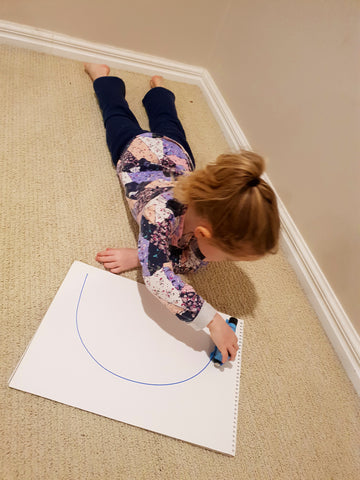What does crossing the midline mean?
What is crossing the midline?
The Child Development Centre describes crossing the midline as the ability to "move our arm or leg across the middle of our body to perform a task. Before midline crossing is well established, children are usually observed to engage in tasks on only one side of their body, e.g.: reaching for an item placed on their left side with only their left hand." (https://www.cdchk.org/parent-tips/what-is-crossing-the-midline/)
When I observe children who haven't yet developed their crossing the midline skills, I see behaviours like:
- Picking up a jigsaw puzzle piece with their right hand, when it is positioned on the right hand side of their body, then picking up a jigsaw puzzle piece with their left hand, when it is positioned on the left hand side of their body.
- Drawing a picture in the middle of their piece of paper, leaving the outside area of the paper blank.
- Painting with their left hand on the area of paper positioned on the left hand side of their body, then painting with their right hand, on the area of paper positioned on the right hand side of their body.
- Difficulty sitting cross-legged without an educator helping them to cross their legs.
- Difficulty putting their own shoes and socks on.
- Difficulty opening up the zip of their own bag.
- Easily distracted when trying to read words across the page from left to right.
- Difficulty hitting a ball with a bat, or kicking a soccer ball with their foot moving across the midline of their body.
- Difficulty climbing, crawling, spinning, skipping, and turning while running.
Access our free crossing the midline routine here
To improve children's crossing the midline skills, they need to practice crossing the midline every day.
Strategies include:
- Crawling through tunnels using the correct opposite hand to knee crawling technique
- Completing a specific crossing the midline routine - find our printable routine here
- Picking up puzzle pieces from the opposite side of their body, while keeping the torso still
- Drawing large images on the pavement with chalk or a wet paint brush
- Drawing horizontal lines from left to right, and right to left, while keeping the torso still
- Driving cars or trucks across their midline, in large, smooth movements
Our goal for children's development, is to master crossing the midline skills, by the age of 4 years. Once children have mastered their crossing the midline skills, they can then start to practice and master their fine motor skills, because they'll be less likely to swap hands with the paint brush, or swap hands to pick up a puzzle piece.
Children with strong crossing the midline skills, become confident to use their dominant hand for complex fine motor tasks. They also become more confident to try gross motor activities such as climbing, dancing, throwing and catching, kicking a ball, etc.
To learn more about crossing the midline, view my Youtube video here - https://youtu.be/WECNZLXNgbQ
If you have any crossing the midline questions, or comments, please feel free to share your thoughts below.






I can’t thank you enough for this article. For over 20 years in the EC industry I have encountered the exact same issues. You and I could be the same person in regards to our passion for teaching and developing fundamental motor skills to all children. Thank you for this and I look forward to delinking more of your articles.
It is easy to overlook the importance of such a crucial developmental skill in our everyday praxis. Thank you for sharing your insightful tips on how to improve such an imperative skill. The article also shed light on how we might already be integrating stategies to improve students capacity to cross the midline.
- i have recently taught my students a Torres Strait Island song ‘Taba Naba’. This was an effective method of incorporating Indigenous perspectives, music and dance and langauage development in everyday practice.
Leave a comment